What’s all this hype about the secondary solar market? It seems like everyone has an opinion about it. But not everyone has experience with it.
That’s where EnergyBin comes in. We are the leading B2B exchange that brings together PV professionals who provide repair, resale, and recycling solutions. Our experience is based on over twenty years of connecting buyers and sellers throughout the world who are engaged in secondary market commerce. Our members are committed to accelerating a robust and sustainable secondary market.
Whether you’re an ambassador, on the fence about it, or you don’t quite buy into it yet, this article will explain why the secondary market is a critical component to ensure a sustainable, circular economy that leaves zero waste.
What is the secondary solar market?
The secondary solar market brings together buyers and sellers to trade goods that have previously been introduced in the primary market. Service providers add value via solutions for repair and refurbishment, resale, and recycling.
A robust secondary market comprises solar developers, EPCs, O&Ms, resellers, repair and testing firms, recycling companies, insurance, and 3rd party warranty firms. Just like in the primary market, this alternative market creates new jobs and additional revenue streams.
As in other industries with mature secondary markets, companies who operate in the solar secondary market are committed to extending a product’s lifecycle and seek to ensure a sustainable, circular economy that leaves zero waste.
How solar equipment comes into the secondary market
There are many pathways of how solar equipment makes its way into the secondary market arena. These are the most common examples that we see from goods traded on EnergyBin. Keep in mind that PV equipment for resale is both new and used.
Surplus and Clearance
Surplus, or overstock, is new equipment under warranty that is left over from manufacturers’ assembly lines. These goods are excess from production batches. Manufacturers are eager to sell these goods at reduced rates to clear lines for new production. Resellers purchase in bulk from manufacturers and then remarket the goods.
Clearance is marked-down inventory that distributors and suppliers have on hand. Clearance doesn’t mean old technology. In the rapidly growing solar industry, manufacturers are consistently pushing out new technology upgrades. Distributors mark down goods when they need to make room in their warehouses for incoming inventory. If their primary customers aren’t in a position to buy, they turn to additional sales channels in the secondary market to increase inventory turnover.
Excess
Large quantities for resale come from excess. It is quite common for developers, EPCs, and installers to order in bulk for upcoming projects. Many wholesalers require a minimum volume order to qualify for discounted rates. Due to the complexity of projects, there’s no guarantee that excess material can be rolled into new project plans. So, companies look for ways to quickly resell their excess to avoid holding costs. They also turn to resale when projects are downsized or cancelled.
Liquidations
With competition in the solar industry comes bankruptcies and closures. When a company closes its doors, assets - including solar equipment in their possession - are resold in the secondary market. Product liquidations and auction lots are offered via bidding, where the highest bidder wins the purchase. Equipment brokers and resellers sometimes bid for these lots in order to remarket the goods to secondary market buyers.
Refurbished Goods and Recycled Material
Used equipment that is still functional, meaning it’s not damaged, tends to have resale value. Companies who specialize in refurbishment and resale provide maintenance, testing, and cleaning before repositioning the used goods for sale. This process gives second life to products that are not yet at end-of-life. Buyers demanding used modules and other solar components are not typically the same buyers that the primary market serves. They are purchasing these goods for uses other than grid-tied projects.
Once a product reaches its end-of-life, the secondary market offers a sustainable option – recycling. Glass, aluminum, and metals are scrapped and smelted by PV recycling facilities. These materials are then resold to buyers in a number of industries for a variety of uses. Recycling keeps these valuable resources out of landfills. For example, glass from PV modules is used for fiberglass, furnace-ready cullet, glass beads for special applications, glass fillers, and more.
Myths debunked
Hesitancy to do business in the secondary solar market is often based on misunderstandings. That’s unfortunate because unless the solar industry embraces the secondary market, we will never achieve a circular economy. Plus, if you’re not paying attention to the secondary market, you could miss out on your next big business opportunity.
Myth: PV equipment for resale is junk.
Fact: PV equipment offered for resale in the secondary market must have resale value. Otherwise, buyers wouldn’t be interested.
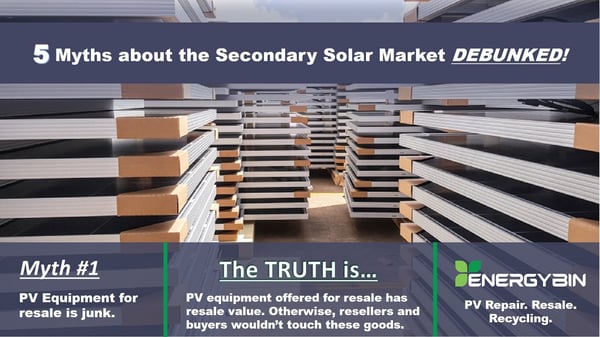
From the millions of solar components bought and sold on EnergyBin’s trading platform, over 90% is new with warranty. These are high quality goods and primarily high efficiency (330 Wp and above with Cello, PERC, HIT-, n-type, or back-contact cells or combination thereof).
Consider these examples of modules for resale:
| Brand | Power Class | Quantity |
| LONGi | 450W | 30 kW |
| TALESUN | 400W | 7 MW |
| ZNSHINE Solar | 395W | 500 kW |
| Hanwha Q-Cells | 435W | 177 kW |
| Seraphim | 425W | 800 kW |
Mainstream modules (those between 275 Wp and 325 Wp) are also in high demand among secondary market buyers. The primary reason being the cost compared to high efficiency, bifacials, and all black modules. These goods are priced at a minimum of $0.10 per watt less than their high efficiency counterparts.
Oftentimes, buyers consider lower efficiency to be a better financial deal. They come to the conclusion that mainstream modules are adequate to meet their energy consumption needs.
This may seem ludicrous to tech experts. But if offering a lower cost option to buyers today means we can accelerate the adoption of solar energy, then it will certainly help advance the great energy transition of our times.
Myth: Used solar equipment is unsafe and should be disposed of.
Fact: Used solar equipment for resale in the secondary market plays a major role in the adoption of solar. These goods have made solar adoption possible for many buyers throughout the world, some of whom didn’t have access to electricity prior to their solar purchases.
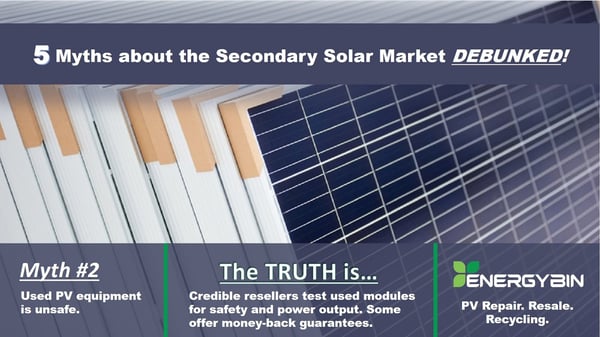
Used goods – especially functioning modules – are not junk! On EnergyBin, we’ve observed used modules selling at megawatt levels. Some are as young as 2-5 years old. They sell quickly – posted one day, and gone the next.
The only reason why these goods are selling is because they have resale value. No reseller would touch these goods if they were junk. The reseller’s reputation is on the line. Why would they risk their credibility by selling goods that were unsafe?
Buyers are in the market for modules that are less than 10 years old. They buy from resellers who have tested modules for safety and power output. Reputable refurbishment firms include service warranties to guarantee their workmanship. Some offer money-back guarantees that assure safety and performance output.
A solar module is at end-of-life when it is unsalvageable, for example, the glass is shattered. When modules reach their end-of-life, they do not have resale value. Instead, they should be recycled.
Myth: Insurance won’t cover repair or refurbished equipment.
Fact: Insurance companies are very familiar with secondary markets. Just like in other industries, insurance companies will seek to identify all options to reveal their most lucrative solution.
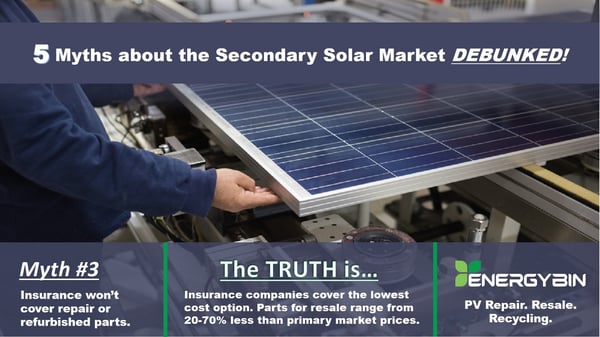
Think of automobiles as an example. If you get into a car accident, you file a claim for the damage. Your insurance company will instruct you to take the car to an auto repair shop to assess the damage. If the damage is salvageable, estimators will search the secondary market for replacement parts. If they can find resale parts that satisfy the safety and performance of your vehicle, they will likely require these parts be ordered instead of sourcing parts from the primary market.
Often, parts for resale range from 20-70% less than primary market prices.
The same is true in the solar industry. Insurance companies work closely with testing firms to assess damage. Testing firms determine if the damage is salvageable. If it is, insurance companies explore options for repair or replacement (new or used components) and weight each option’s cost. They proceed with covering the lowest cost option.
Myth: Recycling is too expensive. It’s easier to dump decommissioned modules in landfills.
Fact: Any module that is unsalvageable should be recycled, not dumped in landfills. As the myth implies, recycling can be construed as expensive, and there's some truth to that. According to PV recycling experts, there are a number of challenges affecting today's sector, which industry leaders are working to address.
But resorting to disposal instead of recycling is contrary to developing a sustainable circular economy. Be part of the solution, not the problem.
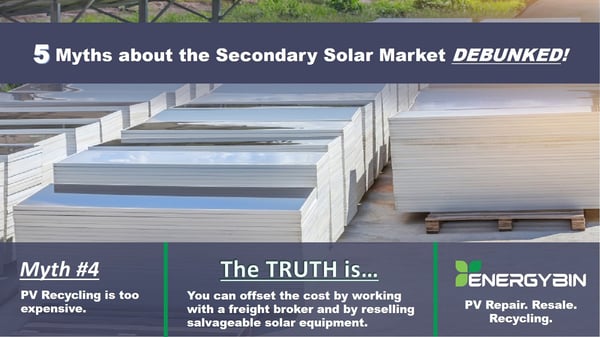
The secondary market provides solutions to ease part of the financial burden.
First of all, understand that there is an expense to recycle, as there is an expense to dispose waste. These are not free services. One of the biggest costs to recycle is freight to move material to a recycling facility. Consult a freight broker to find the most cost-effective options.
Secondly, if you are decommissioning a solar farm and any part is salvageable, note that there are companies who will pay you for the salvageable goods. The money earned can be used to offset the cost to recycle.
Recycled PV material is used for many purposes. Some of the glass is used for new solar modules. But most of the material is sold to other industries for a number of uses, for example, fiberglass.
Committing to a recycling plan is also a wise business decision. It shows that your company really is a leader in sustainability and that you take responsibility for your actions to make a positive impact on the environment. Be part of the solution, not the problem.
Myth: There’s no money to be made in the secondary market.
Fact: From reducing expenses to adding new revenue streams, solar companies of all business models are making money in the secondary market today.
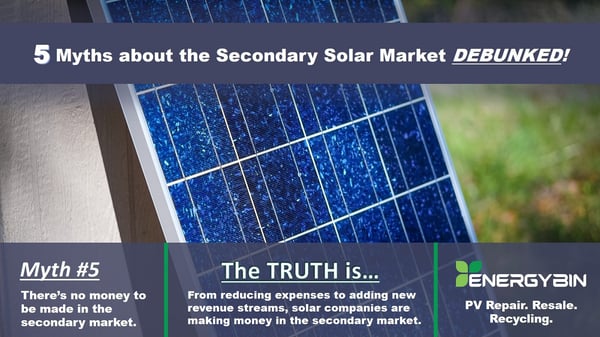
On EnergyBin, we’ve observed members who operate as distributors and suppliers, developers, EPCs, installers, and O&Ms realize success. Many of these members spend most of their time in primary market activities, but they have come to realize that engagement in secondary market activities offers a bountiful source of revenues and profits as well.
Here are a few examples:
- A reseller sold a quantity of 800 Tier 1 mainstream modules (310W, 60-cell) for a profit of $20,000 in one day on EnergyBin.
- A distributor made a profit of $65,000 within three months by creating an additional sales channel via EnergyBin.
- And a small commercial installer saved $7,000 by using EnergyBin for a single Tier 1 high efficiency module order (340W).
These examples illustrate the power of connections that take place in the secondary market. When buyers and sellers come together to trade equipment that has fallen out of the primary market, they make and save money.
Involvement in the secondary market also helps companies fulfill sustainability goals. These companies assure their follow-through on commitments to such goals by partnering with secondary market players who offer services for repair, resale, and recycling.
Join the secondary market today
Your next big business opportunity could very well be waiting for you in the secondary solar market. Perhaps the best way to connect is by joining EnergyBin where you can network with industry peers who are involved in secondary market trade. EnergyBin membership is reserved for solar companies who are committed to accelerating a robust and sustainable secondary market.
Beyond joining our community, view our Resources library for secondary solar market news and get tips from companies who are trading solar equipment on EnergyBin.
Find your next business opportunity here.
You May Also Like:
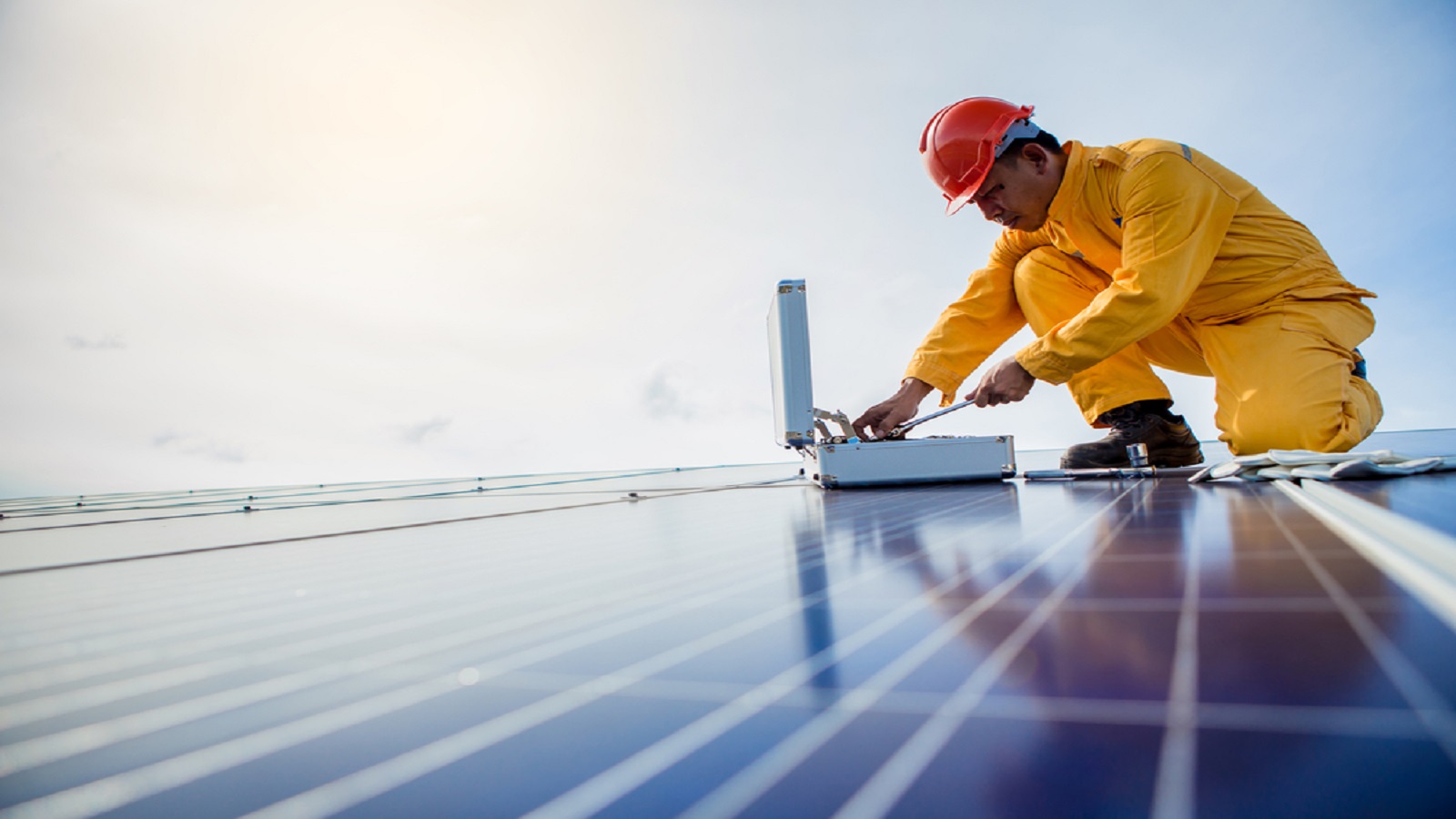

 A Comprehensive Guide to Wholesale Solar Equipment Brokering
A Comprehensive Guide to Wholesale Solar Equipment Brokering